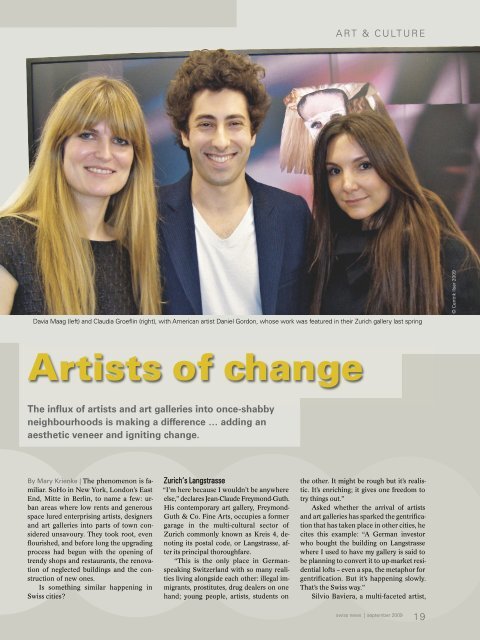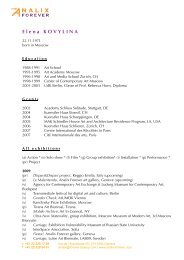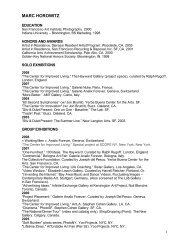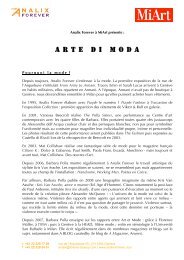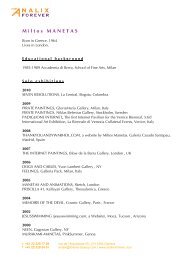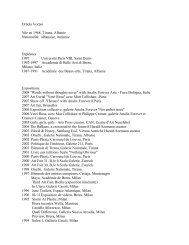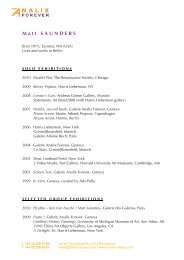art and culture:Layout 1 - Analix Forever
art and culture:Layout 1 - Analix Forever
art and culture:Layout 1 - Analix Forever
You also want an ePaper? Increase the reach of your titles
YUMPU automatically turns print PDFs into web optimized ePapers that Google loves.
ART & CULTURE<br />
© Centrik Ilser 2009<br />
Davia Maag (left) <strong>and</strong> Claudia Groeflin (right), with American <strong>art</strong>ist Daniel Gordon, whose work was featured in their Zurich gallery last spring<br />
Artists of change<br />
The influx of <strong>art</strong>ists <strong>and</strong> <strong>art</strong> galleries into once-shabby<br />
neighbourhoods is making a difference … adding an<br />
aesthetic veneer <strong>and</strong> igniting change.<br />
By Mary Krienke | The phenomenon is familiar.<br />
SoHo in New York, London’s East<br />
End, Mitte in Berlin, to name a few: urban<br />
areas where low rents <strong>and</strong> generous<br />
space lured enterprising <strong>art</strong>ists, designers<br />
<strong>and</strong> <strong>art</strong> galleries into p<strong>art</strong>s of town considered<br />
unsavoury. They took root, even<br />
flourished, <strong>and</strong> before long the upgrading<br />
process had begun with the opening of<br />
trendy shops <strong>and</strong> restaurants, the renovation<br />
of neglected buildings <strong>and</strong> the construction<br />
of new ones.<br />
Is something similar happening in<br />
Swiss cities<br />
Zurich’s Langstrasse<br />
“I’m here because I wouldn’t be anywhere<br />
else,” declares Jean-Claude Freymond-Guth.<br />
His contemporary <strong>art</strong> gallery, Freymond-<br />
Guth & Co. Fine Arts, occupies a former<br />
garage in the multi-cultural sector of<br />
Zurich commonly known as Kreis 4, denoting<br />
its postal code, or Langstrasse, after<br />
its principal thoroughfare.<br />
“This is the only place in Germanspeaking<br />
Switzerl<strong>and</strong> with so many realities<br />
living alongside each other: illegal immigrants,<br />
prostitutes, drug dealers on one<br />
h<strong>and</strong>; young people, <strong>art</strong>ists, students on<br />
the other. It might be rough but it’s realistic.<br />
It’s enriching; it gives one freedom to<br />
try things out.”<br />
Asked whether the arrival of <strong>art</strong>ists<br />
<strong>and</strong> <strong>art</strong> galleries has sparked the gentrification<br />
that has taken place in other cities, he<br />
cites this example: “A German investor<br />
who bought the building on Langstrasse<br />
where I used to have my gallery is said to<br />
be planning to convert it to up-market residential<br />
lofts – even a spa, the metaphor for<br />
gentrification. But it’s happening slowly.<br />
That’s the Swiss way.”<br />
Silvio Baviera, a multi-faceted <strong>art</strong>ist,<br />
swiss news september 2009<br />
19
ART & CULTURE<br />
writer, publisher <strong>and</strong> gallerist who was<br />
born in the neighbourhood <strong>and</strong> the first to<br />
open an <strong>art</strong> gallery there in 1973, has<br />
watched it change over the years, p<strong>art</strong>icularly<br />
in the last five.<br />
“It used to be a lot crazier,” he says.<br />
“Today we still have drugs <strong>and</strong> prostitution,<br />
but also <strong>art</strong>ists, about 15 <strong>art</strong> galleries,<br />
designers, fashion boutiques <strong>and</strong> chic<br />
restaurants … <strong>and</strong> more policemen.”<br />
Baviera stages periodic exhibitions<br />
<strong>and</strong> other ‘happenings’ in his combination<br />
gallery/contemporary <strong>art</strong> museum, which<br />
was dramatically exp<strong>and</strong>ed in 1990 with<br />
the addition of a multi-level exhibition<br />
space behind its modest storefront on<br />
Zwinglistrasse.<br />
Séverine Spillmann <strong>and</strong> René Grüninger promote <strong>art</strong>-compatible design boutiques in<br />
Zurich’s Kreis 4 <strong>and</strong> Kreis 5<br />
Zurich gallery hopping<br />
A few steps down a sort of alleyway from<br />
Zwinglistrasse is one of the more recent<br />
arrivals: Groeflin Maag Galerie, which<br />
opened in 2007. P<strong>art</strong>ners Claudia Groeflin<br />
<strong>and</strong> Davia Maag, both natives of<br />
Basel, met in London, where they received<br />
master’s degrees in <strong>art</strong>, followed by<br />
stints in Zurich galleries. They opened<br />
their first gallery in Basel’s Dreispitz – an<br />
industrial/warehouse area with big cultural<br />
plans, which seem to have stalled – before<br />
relocating to Zurich.<br />
“For us it was always clear that we<br />
would eventually come to Zurich. This is<br />
the centre of the contemporary <strong>art</strong> scene,”<br />
Maag says.<br />
“We love our bunker,” Groeflin adds.<br />
The sparse bunker-like space – formerly a<br />
workshop – is ideal for the contemporary<br />
<strong>art</strong>ists they represent, among them American<br />
Daniel Gordon, whose photographs<br />
of cutout paper images <strong>and</strong> the human<br />
body in extreme situations were the subject<br />
of a spring show.<br />
Zigzagging right, left, right, <strong>and</strong> then<br />
left again from Groeflin Maag, you arrive<br />
at Rotw<strong>and</strong>strasse, where several galleries<br />
have set up shop <strong>and</strong> the gentrification<br />
is palpable.<br />
At Rotw<strong>and</strong> Gallery, Sabine Kohler<br />
<strong>and</strong> Bettina Meier-Bickel, two young veterans<br />
of the Zurich contemporary <strong>art</strong><br />
scene, have found that collectors like to<br />
come to this shabbier p<strong>art</strong> of town – a contrast<br />
to how they live – to discover emerging<br />
talents. “Artists are drawn to places<br />
like this,” Meier-Bickel says. “The area is<br />
getting more <strong>and</strong> more trendy,” she adds,<br />
singling out a restaurant called Volkshaus<br />
<strong>and</strong> the Redroom fashion boutique, right<br />
around the corner. “And business is surprisingly<br />
good, considering the current financial<br />
crisis.”<br />
Parallel design influx<br />
Art galleries <strong>and</strong> design boutiques frequently<br />
develop simultaneously <strong>and</strong><br />
Langstrasse is no exception, with designers<br />
among the area’s pioneers. René<br />
Grüninger, who launched the Pink<br />
Flamingo fashion label with his ex-wife<br />
Ruth in Kreis 4 back in 1976, today runs a<br />
public relations company that promotes<br />
approximately 70 small design <strong>and</strong> fashion<br />
boutiques here – <strong>and</strong> in Kreis 5, another<br />
up-<strong>and</strong>-coming p<strong>art</strong> of town.<br />
In 2006, he decided that there was<br />
strength in numbers <strong>and</strong> formed a loose<br />
association of like-minded merchants.<br />
Centrepiece of their activities is an annual<br />
promotional campaign, culminating in a<br />
weekend in May when the shops remained<br />
open on Sunday.<br />
While the area is clearly becoming a<br />
thriving <strong>art</strong>, shopping <strong>and</strong> restaurant destination,<br />
he says that many locals are<br />
wary of the term ‘gentrification’. “They<br />
don’t want it to become too chic,” he says.<br />
One decidedly chic destination, however,<br />
is Fabric Frontline, founded by one<br />
of Zurich’s most colourful entrepreneurs,<br />
Andi Stutz, <strong>and</strong> his two sisters in 1980.<br />
The company, which specialises in very<br />
high-quality silk scarves, neckties <strong>and</strong> fabrics,<br />
which it sells to top international de-<br />
© Séverine Spillmann <strong>and</strong> René Grüninger<br />
20<br />
swiss news september 2009
ART & CULTURE<br />
© Annil Wetter<br />
Faye Fleming exhibits the work of emerging <strong>art</strong>ists from several countries in her gallery in<br />
Geneva’s QuARTier des Bains<br />
© Galerie von B<strong>art</strong>ha<br />
Stefan von B<strong>art</strong>ha’s “<strong>art</strong> garage” in the<br />
St. Johann area of Basel features <strong>art</strong>ists<br />
on the cutting edge<br />
© Barbara Polla<br />
Geneva gallerist Barbara Polla with collector Gérard Millet (left) <strong>and</strong> <strong>art</strong>ist Mario Rizzi (right),<br />
winner of the 2009 Prix du QuARTier des Bains<br />
signers, moved to Kreis 4 in 1985.<br />
“Everyone thought I was completely<br />
crazy,” Stutz recalls. “It was incredibly<br />
shabby <strong>and</strong> there wasn’t a tree in sight.”<br />
So he created his own veritable jungle<br />
of trees <strong>and</strong> flowers, which today surrounds<br />
three adjoining buildings that<br />
house the showroom, boutique <strong>and</strong> a stylish<br />
restaurant.<br />
“The area is still heavily foreign, <strong>and</strong><br />
the red light district remains, but now<br />
there are more <strong>and</strong> more restaurants, <strong>and</strong><br />
at least six clubs,” he says. “Many people<br />
still think this is a strange place to be. It’s<br />
considered dangerous. Yet the pickpockets<br />
don’t come here; they stick to the<br />
Bahnhofstrasse.”<br />
Geneva’s QuARTier des Bains<br />
Geneva’s answer to Zurich’s Kreis 4/<br />
Lang strasse is promoted as QuARTier des<br />
Bains, a nod to the cluster of a dozen<br />
or so contemporary <strong>art</strong> galleries located<br />
on rue des Bains <strong>and</strong> the surrounding<br />
streets, which hold periodic simultaneous<br />
vernissages.<br />
The neighbourhood is less animated,<br />
less rough ’n ready than its Zurich counterp<strong>art</strong><br />
– but then that’s Geneva.<br />
“This was just a normal place” before<br />
<strong>art</strong>ists <strong>and</strong> <strong>art</strong> galleries st<strong>art</strong>ed arriving,<br />
according to Barbara Polla. She <strong>and</strong> her<br />
husb<strong>and</strong> Luigi, both medical doctors, installed<br />
their cutting-edge <strong>Analix</strong> <strong>Forever</strong><br />
gallery there in 1993. They established a<br />
policy of introducing emerging <strong>art</strong>ists,<br />
among them such international notables<br />
as Sarah Lucas <strong>and</strong> Tracey Emin, to<br />
French-speaking Switzerl<strong>and</strong>.<br />
About the same time, a former factory<br />
site was converted to an <strong>art</strong> complex,<br />
housing the Museum of Modern <strong>and</strong> Contemporary<br />
Art (MAMCO) <strong>and</strong> the Centre<br />
d’Art Contemporain (CAC).<br />
“Now ‘les Bains’ has become the<br />
trendy place to be for the young <strong>and</strong> <strong>art</strong>y,”<br />
Polla says. The place was hopping during<br />
the well-attended evening openings this<br />
past May, when at least three new galleries<br />
opened their doors: quite extraordinary<br />
in these economic times.<br />
The area did have a certain negative<br />
swiss news september 2009<br />
21
ART & CULTURE<br />
notoriety, however, as the young Englishwoman<br />
who opened the Faye Fleming/Arquebuse<br />
gallery in 2006 found out when<br />
she was looking for a suitable space.<br />
“Estate agents warned me that the<br />
area wasn’t safe,” she recalls. That didn’t<br />
deter Fleming, a veteran of Shoreditch<br />
<strong>and</strong> other dodgy areas in London’s East<br />
End. She found the perfect spot, a former<br />
garage for water pump vehicles, where<br />
she shows the work of emerging <strong>art</strong>ists<br />
from several countries.<br />
What about Basel<br />
In contrast to Zurich’s dynamic scene,<br />
Basel, whose museums rank among the<br />
world’s greatest <strong>and</strong> where the <strong>art</strong> world<br />
converges each June for the annual Art<br />
Basel fair, doesn’t really have a concentration<br />
of <strong>art</strong> galleries. In fact, they’re few<br />
<strong>and</strong> far between.<br />
Erlenmatt, a scruffy neighbourhood<br />
located behind the Basel Messe, showed<br />
potential for <strong>art</strong>-impelled regeneration,<br />
when <strong>art</strong>ists, designers <strong>and</strong> other creative<br />
types st<strong>art</strong>ed claiming the area as their<br />
own around 2000.<br />
There, Marc de Puechredon saw an<br />
opportunity to create a contemporary cultural<br />
conglomerate in E-Halle, a vast<br />
4,000-square-metre customs hall adjacent<br />
to the former German railway yards,<br />
where a huge residential complex is under<br />
construction.<br />
He established an <strong>art</strong> gallery in p<strong>art</strong> of<br />
the space in 2007, which left plenty of<br />
room for a restaurant <strong>and</strong> other alternative<br />
cultural activities. He had hoped the<br />
development project would reflect the<br />
<strong>art</strong>istic drift of the neighbourhood, but<br />
this doesn’t appear to be happening.<br />
While E-Halle remains p<strong>art</strong> of the initial<br />
regeneration, its long-range future is a<br />
question mark.<br />
Undeterred – even inspired – by this<br />
residential behemoth next door, de<br />
Puechredon <strong>and</strong> Clare Kenny, the<br />
gallery’s curator <strong>and</strong> exhibitions manager,<br />
are planning a 2010 show called ‘Home<br />
Sweet Home’, featuring reflections by several<br />
<strong>art</strong>ists on neighbourhood development<br />
<strong>and</strong> how people live in such surroundings.<br />
The show will draw on Kenny’s personal<br />
experience of p<strong>art</strong>icipating in the<br />
emergence of London’s East End <strong>art</strong><br />
scene, as well as the thesis she wrote for<br />
her master’s degree from the Chelsea<br />
School of Art in London, which examined<br />
links between <strong>culture</strong> <strong>and</strong> industry.<br />
Jean-Claude Freymond-Guth says of his contemporary <strong>art</strong> gallery in Zurich’s<br />
Langstrasse area, “I wouldn’t be anywhere else.”<br />
Ripe for change<br />
Asked what other Basel neighbourhoods<br />
might prove fertile ground, Kenny suggested<br />
St. Johann, <strong>and</strong> so I decided to take a<br />
look. Located 10 minutes by tram from the<br />
Bahnhof, this is a mixed residential neighbourhood,<br />
with ‘shabby chic’ potential. I<br />
discovered that <strong>art</strong> had already taken root<br />
– in the form of Galerie von B<strong>art</strong>ha, with<br />
two gas pumps out in front. Stefan von<br />
B<strong>art</strong>ha, whose father is a well-known Basel<br />
<strong>art</strong> dealer, decided to apply his experience<br />
gained while working for Galerie Nordenhake<br />
in Berlin <strong>and</strong> st<strong>art</strong> a contemporary<br />
adjunct to the family business.<br />
Looking for a large space at low cost,<br />
he ran across a combination gas station/<br />
garage, which he describes as “really, really,<br />
really bad but absolutely perfect”. He<br />
converted it to a sleek 750-square-metre<br />
gallery that opened in June 2008, plus an<br />
ap<strong>art</strong>ment, garage <strong>and</strong> storage space. He<br />
leased the pumps to Avia: a win-win situation.<br />
St. Johann already has a sort of <strong>art</strong>y<br />
edge, with a non-profit <strong>art</strong>ists’ cooperative<br />
called New Jersey nearby, many students,<br />
<strong>art</strong>ists <strong>and</strong> graphic designers in the<br />
vicinity <strong>and</strong> active urban development underway.<br />
Not as dramatic as in New York, London<br />
or Berlin … but it’s happening.<br />
Shopping on Zurich’s Langstrasse<br />
© Jean-Claude Freymond-Guth<br />
© Zurich Tourism / M<strong>art</strong>in Rutschi<br />
22<br />
swiss news september 2009


